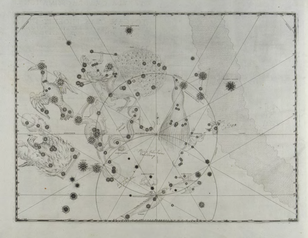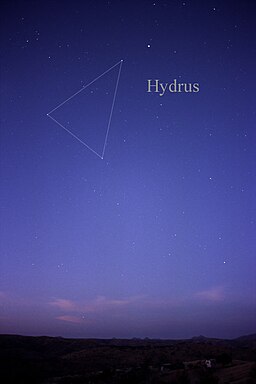Little water snake
|
Constellation Little Water Snake |
|
|---|---|
| Latin name | Hydrus |
| Latin genitive | Hydri |
| Abbreviation | Hyi |
| Right ascension | 00 h 06 m 08 s to 04 h 35 m 11 s |
| declination | −82 ° 03 ′ 52 ″ to −57 ° 50 ′ 54 ″ |
| surface | 243.035 deg² rank 61 |
| Completely visible | 7.9 ° N to 90 ° S |
| Observation time for Central Europe | not visible |
| Number of stars brighter than 3 mag | 2 |
| Brightest star (size) | Beta Hydri (2.82) |
| Meteor streams | |
|
Neighboring constellations ( clockwise from north ) |
|
| swell | IAU , |
 From the Uranometria by Johann Bayer . The kl. Water snake is in the middle. |
|
The little water snake ( Latin hydrus ), also called the southern water snake or male water snake , is a constellation of the southern sky.
description
The little water snake is a little pronounced constellation, only two stars are brighter than the 3rd magnitude . It is found south of the bright Achernar , the southernmost star of Eridanus . It lies between the Large Magellanic Cloud (LMC) and the Small Magellanic Cloud (SMC).
The little water snake is not visible from Europe. They can only be fully observed from locations south of the 8th parallel .
history
The Little Water Snake is one of the constellations introduced by the Dutch navigators Pieter Dirkszoon Keyser and Frederick de Houtman at the end of the 16th century . Johann Bayer took it over in his 1603 sky atlas Uranometria .
It is the southern counterpart of the northern or "female" water snake (lat. Hydra).
Celestial objects
Stars
| B. | Names or other designations | Vmag (mag) | Lj | Spectral class |
|---|---|---|---|---|
| β | Beta Hydri | 2.82 | 24.4 | G1 IV |
| α | Alpha Hydri | 2.86 | 71 | F0 V |
| γ | 3.26 | 150 | M1 III | |
| δ | 4.08 | |||
| ε | 4.12 | |||
| η 2 | 4.68 | 217 | G8 III | |
| ν | 4.76 | |||
| ζ | 4.83 | |||
| λ | 5.09 | |||
| μ | 5.27 | |||
| ι | 5.51 | |||
| θ | 5.51 | |||
| π 1 | 5.57 | |||
| π 2 | 5.67 | |||
| κ | 5.99 | |||
| τ 2 | 6.05 | |||
| σ | 6.15 | |||
| τ 1 | 6.33 |
Beta Hydri is one of the closest stars to the Sun, only 24.4 light years away . It is a yellowish shining star of the spectral class G1 IV. It has a mass similar to that of our sun, but at an age of around seven billion years it has been further developed and has expanded to a diameter of over two million kilometers.
Alpha Hydri is a white shining star of the spectral class F0 V, 71 light-years away.
The star SMSS0313 - 6708 is said to be the oldest known star.

